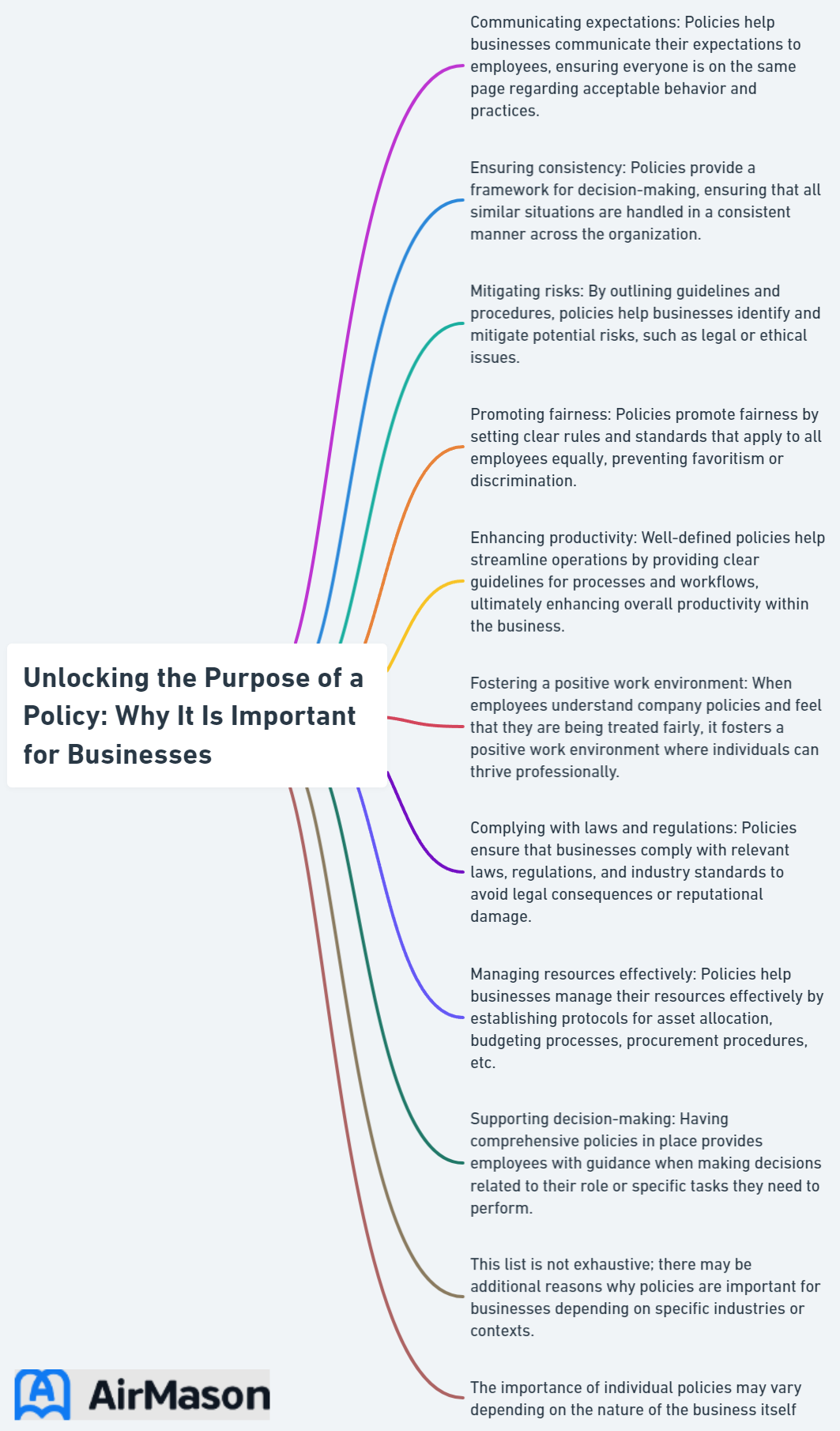
Imagine a workplace with no rules or guidelines—a complete chaos, right? Company policies play a crucial role in shaping the daily operations, employee behavior, and overall success of a business. In this blog post, we will delve into the importance of company policies, their core purpose of a policy, and how they affect day-to-day operations. We will also explore best practices and tools for policy management, ensuring a smooth and efficient implementation of policies that support company culture and success.
Key Takeaways
- Company policies are essential for maintaining consistency, compliance, and alignment with an organization’s mission & values.
- Effective implementation of policies requires employee handbooks and training courses to ensure understanding & adherence.
- Involving employees in policy development can lead to improved morale, productivity & business success.
The Core Purpose of Company Policies
Successful organizations depend on company policies for consistency in internal processes, alignment with the company’s mission and values, and compliance with laws and regulations. These policies not only provide clear guidance to employees but also enable employers to effectively manage their staff, ensuring everyone follows the company rules.
The absence of policies and procedures can lead to inconsistent processes across the organization, resulting in potential confusion and inefficiency.

Consistency in Internal Processes
Stability in business operations is achieved through a well-defined policy framework that fosters consistency in internal processes. Managers and supervisors can utilize procedure checklists and reporting mechanisms to ensure employees adhere to the guidelines, which are in line with the company’s values. It is imperative that employees understand the repercussions of not adhering to policies and procedures to foster accountability and maintain quality service for customers.
In turn, adherence to consistent processes results in consistent customer service and improved quality of products and services.
How to Write a Policy
When tackling the task of creating a policy, understanding the essential steps of “how to write a policy” is crucial. Begin by clearly defining the purpose and scope of the policy, ensuring that its objectives align with organizational goals. Conduct thorough research to gather relevant information and insights that will inform the policy’s content. Structure the document logically, using concise language and providing clear guidelines for implementation. Seek input from key stakeholders to ensure inclusivity and garner diverse perspectives. Regularly review and update the policy as needed to adapt to changing circumstances, maintaining its effectiveness over time. Following these steps will help you craft a well-formulated and impactful policy for your organization.
Compliance with Laws and Regulations
Adhering to laws and regulations, including safety policies, is imperative for businesses to avert legal difficulties and sustain a favorable reputation. Implementing policies and procedures that outline proper customer service, social media management, and communication plans may help your organization lessen the damage in a crisis.
It is of paramount importance for companies to communicate legal requirements and repercussions to employees to ensure that they are acting in accordance with the law and are aware of the consequences of disregarding it, including potential liability risks.
Alignment with Company’s Mission and Values
Aligning company policies with the organization’s mission and values directs business decisions, motivates employees, creates loyalty, and characterizes the identity and purpose of the company. Company policies can reflect the organization’s mission and values by outlining rules, standards, and expectations in accordance with the mission and values.
When policies align with a company’s mission and values, it encourages employees to consider how their actions contribute to the success and positive culture of the company.
The Role of Policies in Day-to-Day Operations

In daily operations, policies guide employees by setting clear expectations, aiding in new hire onboarding, and managing workplace issues. Without well-defined policies and procedures, employees may not have convenient access to an up-to-date policy and procedure manual, leaving them unaware of the correct procedures to follow. This lack of guidance can lead to inefficiencies and legal risks for the business.
Setting Clear Expectations for Employees
Establishing clear expectations for employees assists in directing their conduct and decision-making, thereby fostering a more productive and harmonious work environment. Workplace policies and procedures offer employees a clear understanding of the expectations placed upon them in all areas of their employment, in addition to safeguarding organizations from legal repercussions in the event of any disruption.
Clear expectations allow employees to work more efficiently and prevent misunderstandings that could lead to workplace conflicts.
Facilitating Onboarding of New Hires
The onboarding process for new hires is streamlined by well-defined policies and procedures, enabling them to integrate smoothly into the corporate culture. By providing explicit expectations, objectives, and performance metrics, policies can help new hires comprehend their roles and responsibilities more thoroughly, avoiding role ambiguity and discord.
Policies also communicate the company’s goals and work towards them, augmenting employee engagement and productivity.
Addressing Workplace Issues
The implementation of policies can be instrumental in resolving workplace issues and creating a productive atmosphere. Utilizing established policies to handle workplace issues assists in the resolution of conflicts and the preservation of a positive work environment.
Moreover, having policies in place for common workplace issues, such as health and safety, peer or customer interactions, and hiring, helps maintain a positive and efficient work environment.
Implementing Policies: From Employee Handbook to Training Courses

Policy implementation entails the creation of an effective employee handbook, the development of in-depth training courses, and the monitoring of policy adherence. An up-to-date employee handbook is essential for ensuring all employees have access to the company’s policies and procedures, promoting understanding and compliance.
Along with the employee handbook, comprehensive training courses are critical for employees to gain the knowledge and skills necessary to adhere to company policies and perform their job duties effectively.
Creating an Effective Employee Handbook
An effective employee handbook provides all employees with access to company regulations and processes, promoting understanding and compliance. To communicate company policies effectively through an employee handbook, it is recommended to tailor the communication to suit the audience, make it relevant, clear, and respectful, and introduce the handbook during the onboarding process.
Having a well-written and easily accessible employee handbook can significantly contribute to a more harmonious and efficient workplace.
Developing Comprehensive Training Courses
In-depth training courses equip employees with the knowledge and skills needed to comply with company policies and perform their job duties effectively. Investing in quality training courses not only helps employees adhere to company policies but also improves employee performance and productivity.
Implementing effective training methods, such as in-person demonstrations or online modules, can further enhance employee understanding and compliance with company policies.
Monitoring Policy Compliance
Monitoring policy adherence is crucial for identifying areas of improvement and ensuring consistent compliance with policies. Utilizing policy management software, such as PowerDMS, DocTract, or Risk Cloud, can help organizations streamline the policy management process and ensure compliance with regulations and standards.
Moreover, engaging employees in policy development can help them recognize the significance of following policies and contribute to a more successful implementation of policies.
Policy Template Word
When crafting policies for your organization, utilizing a well-designed policy template Word can significantly streamline the process. A policy template Word provides a structured framework, making it easier to articulate guidelines, procedures, and expectations. By employing a policy template Word, you ensure consistency and professionalism in your documentation. This tool allows you to customize policies to suit your specific needs, saving time and effort in the creation and maintenance of essential documents. Whether you’re developing HR policies or outlining safety procedures, a thoughtfully designed policy template Word is an invaluable resource for creating clear, comprehensive, and easily accessible guidelines for your team.
Enhancing Company Culture Through Defined Policies

The implementation of well-defined policies can have several benefits for a company, including:
- Boosting company culture
- Fostering a positive work environment
- Encouraging employee engagement
- Contributing to the success of the company
Policies that align with the company’s mission and company’s values not only guide business decisions but also motivate employees and create loyalty, ultimately contributing to a more productive and harmonious work environment.
Promoting a Positive Workplace Culture
Through the implementation of policies that promote a positive workplace culture, businesses can create a supportive and inclusive environment where employees can thrive. Implementing inclusivity and diversity policies in the workplace can potentially yield a range of benefits, such as:
- Attracting and retaining a diverse workforce
- Creating a sense of belonging among employees
- Providing support for employees
- Stimulating innovation
- Cultivating an inclusive culture
Encouraging Employee Engagement
Encouraging employee engagement in policy development and implementation fosters a sense of ownership and commitment to the company’s success. By involving employees in the policy formation process and promoting open communication, businesses can ensure that employees understand and comply with company policies, resulting in:
- Improved policy implementation
- Increased employee satisfaction and morale
- Enhanced productivity and efficiency
- Reduced risk of policy violations
- Overall business success
Examples of companies that have successfully incorporated employee input in policy formation include Kaiser Permanente, Southwest Airlines, and Hilton.
Supporting Company Success
Supporting company success through well-defined policies ensures that all aspects of the business are aligned and working towards common goals. Policy alignment with business goals plays a pivotal role in company success by ensuring that all employees and departments are working towards the same objectives, fostering a cohesive and focused work environment.
When policies are aligned with business goals, it creates a clear direction for the organization and increases the likelihood of achieving long-term success.
Policy Management: Best Practices and Tools for Success

Successful implementation and upkeep of company policies require a robust policy management process, use of policy management software, and active employee involvement in policy development. Employing best practices and tools for policy management can help organizations maintain compliance and consistency, ensuring that policies are effectively guiding employee behavior and decision-making.
Establishing a Policy Management Process
An effective policy management process includes the following steps:
- Establishing a workflow for policy creation
- Drafting and reviewing the policy
- Distributing the policy to relevant parties
- Monitoring employee responses and compliance
- Evaluating the policy’s effectiveness
- Making necessary changes based on feedback and assessment
- By following these steps, you can ensure that your policy is well-managed and effectively implement policies.
Regularly communicating policies and procedures, employing face-to-face communication for policy changes, soliciting feedback from employees, making policies easily accessible, and gaining leadership buy-in are some measures that can be taken to guarantee successful communication of policies to employees.
Utilizing Policy Management Software
When it comes to compliance management, software like Workiva, MyComplianceOffice, NAVEX One, LogicGate Risk Cloud, and PowerDMS can help ensure that your team is on the same page.
can simplify the creation, update, and distribution of policies, aiding in maintaining compliance and coherence. These software options automate various tasks, grant centralized access to policy documents, standardize the policy format, introduce review workflows, expedite approval processes, guarantee regular policy updates, and simplify the distribution of policies.
Engaging Employees in Policy Development
Employee participation in policy development fosters understanding and buy-in, leading to enhanced compliance and more effective policy implementation.
Implementing a centralized policy management system, instituting a transparent policy development process, furnishing training and resources to personnel, cultivating open communication and collaboration, and acknowledging employee contributions can help surmount the difficulties encountered in involving personnel in policy development.
Policy Vs Rule
When navigating the dynamics of organizational governance, understanding the distinction between “policy vs rule” is crucial. In essence, a policy is a broader guiding principle that sets the tone for decision-making, offering a framework for desired outcomes. On the other hand, a rule is more specific, outlining explicit actions or restrictions that must be adhered to. While a policy provides flexibility, allowing for interpretation and adaptation, a rule is more rigid, establishing clear boundaries. Striking the right balance between policies and rules is essential for creating an effective and adaptable system of governance that promotes both order and flexibility.
Summary
In conclusion, company policies play a vital role in shaping an organization’s success by ensuring consistency in internal processes, compliance with laws and regulations, and alignment with the company’s mission and values. Through effective policy management practices and tools, businesses can create a positive workplace culture, encourage employee engagement, and support overall company success. By investing in the development and implementation of well-defined policies, organizations can ensure a more harmonious and efficient work environment, ultimately leading to long-term success.
Frequently Asked Questions
What are the main reasons to write policies?
Writing policies is important for providing a framework and background to supervisors, so they can make difficult decisions and explain why they are the right ones. It also helps enforce rules consistently.
What is the purpose section of a policy?
The purpose section of a policy outlines the statement of the policy, who it applies to, and why it is being issued. It also indicates the place of the policy within the organization.
What are the benefits of a policy?
A policy provides clear instruction, allowing staff to make decisions efficiently and confidently, while reducing bias in decision-making.
What is the primary objective of company policies?
The primary objective of company policies is to ensure consistent processes across the organization, ensuring uniformity in internal procedures, adherence to laws and regulations, and agreement with the company’s mission and values.
How can company policies reflect the organization’s mission and values?
Company policies are an effective way to ensure that employees are aware of and abide by the mission and values of the organization, as they clearly outline the rules, standards, and expectations.